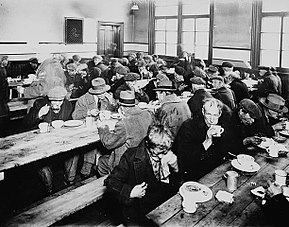
Back مطعم الفقراء Arabic Безплатна трапезария Bulgarian Menjador social Catalan Folkekøkken Danish Suppenküche German Supokuirejo Esperanto Comedor social Spanish نوانخانه Persian Kansankeittiö Finnish Soupe populaire French

A soup kitchen, food kitchen, or meal center is a place where food is offered to the hungry usually for free or sometimes at a below-market price (such as coin donations). Frequently located in lower-income neighborhoods, soup kitchens are often staffed by volunteer organizations, such as church or community groups. Soup kitchens sometimes obtain food from a food bank for free or at a low price, because they are considered a charity, which makes it easier for them to feed the many people who require their services.
Historically, most soup kitchens served only soup or stew, usually with bread. Modern establishments which refer to themselves as "soup kitchens" frequently serve a wider variety of foods, so social scientists sometimes discuss them together with similar hunger relief agencies that provide more varied hot meals, such as community kitchens and meal centers.
While societies have been using various methods to share food with the hungry for millennia, the first soup kitchens in the modern sense may have emerged in the late 18th century. By the late 19th century, they were located in several American and European cities. In the United States and elsewhere, they became more prominent in the 20th century, especially during the Great Depression. With the much-improved economic conditions that immediately followed World War II, soup kitchens became less common in countries with advanced economies.
In the 21st century, the use of soup kitchens has increased in both the United States and Europe, following lasting global increases in the price of food which began in late 2006. Demand for their services grew as the Great Recession and the economic and inflation crisis of the 2020s began to worsen economic conditions for those with lower incomes. In much of the UK and Europe, demand further increased after the introduction of austerity-based economic policies from 2010. For instance, Emma Middleton, a poverty caseworker in the UK stated in 2017 that the situation and need for emergency food aid in the UK had changed significantly over the last 15 years, as the cost of living increased and the existing safety nets disappeared, adding "In the first few years [of this work], food poverty was not an issue. The soup kitchens and churches could deal with it, and it was mainly homelessness. You never saw families like that. What we see now is a constant stream of food poverty."[1]
© MMXXIII Rich X Search. We shall prevail. All rights reserved. Rich X Search